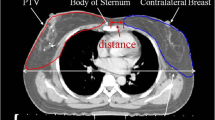Background and Purpose:
There is concern about the increase of radiation-induced malignancies with the application of modern radiation treatment techniques such as intensity-modulated radiotherapy (IMRT) and proton radiotherapy. Therefore, X-ray scatter and neutron radiation as well as the impact of the primary dose distribution on secondary cancer incidence are analyzed.
Material and Methods:
The organ equivalent dose (OED) concept with a linear-exponential and a plateau dose-response curve was applied to dose distributions of 30 patients who received radiation therapy of prostate cancer. Three-dimensional conformal radiotherapy was used in eleven patients, another eleven patients received IMRT with 6-MV photons, and eight patients were treated with spot-scanned protons. The treatment plans were recalculated with 15-MV and 18-MV photons. Secondary cancer risk was estimated based on the OED for the different treatment techniques.
Results:
A modest increase of 15% radiation-induced cancer results from IMRT using low energies (6 MV), compared to conventional four-field planning with 15-MV photons (plateau dose-response: 1%). The probability to develop a secondary cancer increases with IMRT of higher energies by 20% and 60% for 15 MV and 18 MV, respectively (plateau dose-response: 2% and 30%). The use of spot-scanned protons can reduce secondary cancer incidence as much as 50% (independent of dose-response).
Conclusion:
By including the primary dose distribution into the analysis of radiation-induced cancer incidence, the resulting increase in risk for secondary cancer using modern treatment techniques such as IMRT is not as dramatic as expected from earlier studies. By using 6-MV photons, only a moderate risk increase is expected. Spot-scanned protons are the treatment of choice in regard to secondary cancer incidence.
Hintergrund und Ziel:
Durch den Einsatz moderner Bestrahlungstechniken, wie intensitätsmodulierte Strahlentherapie (IMRT) und Protonentherapie, könnte die Anzahl strahleninduzierter Zweittumoren zunehmen. Deswegen wird der Einfluss von Röntgen- und Neutronenstreustrahlung (Tabelle 2) sowie der primären Dosisverteilung auf die Inzidenz von Sekundärtumoren quantifiziert.
Material und Methodik:
Das Konzept der Organäquivalentdosis (OED) mit einer linear-exponentiellen und einer Plateau-Dosis-Wirkungs-Beziehung wurde auf die Dosisverteilungen von 30 Patienten mit Prostatakarzinom (Tabelle 1) angewendet. Von den 30 Patienten wurden elf mit konformaler Radiotherapie, elf mit 6-MV-IMRT und acht mit Protonentherapie („spot-scanned“) behandelt. Die Bestrahlungspläne wurden für 15-MV- und 18-MV-Photonen neu optimiert. Die OED für die verschiedenen Bestrahlungstechniken (Tabelle 3, Abbildung 1) ist proportional zur Sekundärtumorwahrscheinlichkeit.
Ergebnisse:
Wird anstatt konventioneller Vier-Felder-Planung (15-MV-Photonen) ein 6-MV-IMRT-Plan verwendet, steigt die Anzahl strahleninduzierten Tumoren um etwa 15% an (Plateau-Dosis-Wirkungs-Beziehung: 1%). Wird allerdings eine höhere Photonenenergie für die IMRT verwendet (Abbildung 1), steigt die Wahrscheinlichkeit, einen Zweittumor zu entwickeln, um 20% für 15 MV bzw. um 60% für 18 MV an (2% bzw. 30% für eine Plateau-Dosis-Wirkungs-Beziehung). Verwendet man Protonentherapie („spot-scanned“) für die Behandlung, kann die Sekundärtumorinzidenz, unabhängig von der Dosis-Wirkungs-Beziehung, um 50% vermindert werden.
Schlussfolgerung:
Wird neben der Streu- und Neutronenstrahlung auch die primäre Dosisverteilung in die Analyse der Sekundärtumorinzidenz mit einbezogen, steigt das Risiko für einen Zweittumor beim Einsatz der IMRT nicht so dramatisch an, wie in früheren Studien vorhergesagt. Verwendet man ausschließlich 6-MV-Photonen für die IMRT, wird das Sekundärtumorrisiko nur leicht erhöht. Der Einsatz der Protonentherapie kann in Bezug auf die Entstehung von Zweittumoren gegenüber der Photonentherapie von Vorteil sein.
Similar content being viewed by others
Author information
Authors and Affiliations
Corresponding author
Rights and permissions
About this article
Cite this article
Schneider, U., Lomax, A., Pemler, P. et al. The Impact of IMRT and Proton Radiotherapy on Secondary Cancer Incidence. Strahlenther Onkol 182, 647–652 (2006). https://doi.org/10.1007/s00066-006-1534-8
Received:
Revised:
Issue Date:
DOI: https://doi.org/10.1007/s00066-006-1534-8




